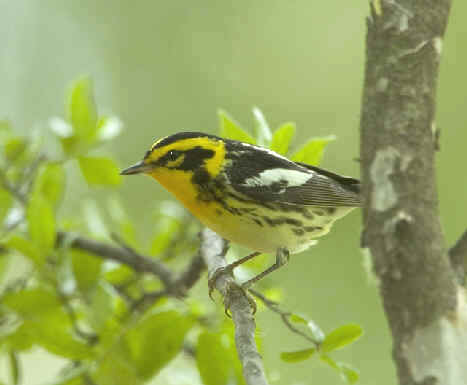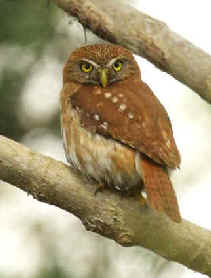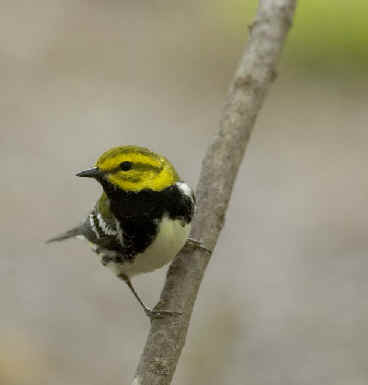
E-mail: font@focusonnature.com
Phone: Toll-free in USA 1-888-721-3555
or 302/529-1876
 |
PO
Box 9021, Wilmington, DE 19809, USA E-mail: font@focusonnature.com Phone: Toll-free in USA 1-888-721-3555 or 302/529-1876 |
A Focus On Nature Tour
in
TEXAS
In the spring
FOR
bIRDS, BUTTERFLIES, BATS,
& OTHER NATURE
From rockport on the gulf
to the lower rio grande valley
and the edwards plateau
April 22-30, 2016
(tour FON/TX-2
'16)
To include, at a prime-time
for Texas birding,
many, many birds.
Among the specialties:
the GOLDEN-CHEEKED WARBLER, BLACK-CAPPED VIREO,
GREEN JAY, and BUFF-BELLIED HUMMINGBIRD.
Notable birds in
the southern Texas during recent years have included
these normally seen in Mexico:
Crimson-collared Grosbeak, White-throated Robin, Social Flycatcher,
Rufous-capped Warbler, Golden-crowned Warbler, Tropical Parula,
Blue Bunting, and Green-breasted Mango
(Some birds such as these may be seen during this tour)

Black-capped Vireo in
Texas
(photo by Clair de
Beauvior)
Tour to be led by Armas
Hill
Links:
A List & Photo Gallery of Texas Birds in 2 Parts:
Part
#1: Quails to Becard
Part
#2: Flycatchers to Buntings
Lists of Other Texas Wildlife (each with
some photos)
Mammals Butterflies
Dragonflies & Damselflies
Amphibians & Reptiles
Texas Wildflowers Plants of the Desert & some nearby habitats (with some photos)

Itinerary (price
follows):
Fri:
Apr 22 Arrival in Corpus Christi,
Texas. Travel north to the coastal
town of Rockport, to be our base for
the first few days of the tour.
In the afternoon, we'll visit the the Aransas
National Wildlife Refuge (a place renowned for Whooping
Cranes from fall thru spring). The refuge, of over 50,000 acres, is
on the Blackjack Peninsula, and
incorporates a number of different habitats wooded sand dunes, brushlands, oak
"mottes", grass meadows, cordgrass prairies, tidal marshes, freshwater
ponds, and marine bays. About 8,500 acres is open to the public, and there is a
16-mile auto loop-road. Nesting
birds on the refuge include: Pauraque, White-tailed Hawk, Northern Crested
Caracara, Purple Gallinule, Wilson's Plover, and Cassin's Sparrow.
Other wildlife of the refuge include: American Alligator, White-tailed Deer,
Collared Peccary (Javelina), Armadillo, and Coyote.
The first of two overnights in Rockport.

Northern Crested Caracara
(photo by Howard
Eskin)
Sat: Apr 23
This morning, a boat-ride in the marshes near the Aransas Refuge. If some Whooping Cranes are still about (and some may be in late April), we should get a good, close look. A number of birds, of various sorts, will be seen from the boat.
male Painted Bunting
There are many in Texas in April
(photo by Clair de
Beauvior)
Sun: Apr 24
Rockport, where we spent our first two nights, is on the Live Oak Peninsula. Large concentrations landbirds occur on the peninsula in migration. Mid-April to mid-May is the peak time. Franklin's Gull, Yellow-bellied Flycatcher, Veery, Gray-cheeked Thrush, and Philadelphia Vireo are regular migrants. Herons and egrets, other waterbirds, and shorebirds, will also be common. Before we leave Rockport, we'll visit Goose Island State Park, where, in addition to some migrants as those just-mentioned, we could see Reddish Egret, Least Bittern, Roseate Spoonbill, Black-bellied Whistling-Duck, Clapper Rail, Gull-billed and Sandwich and other Terns, and Seaside Sparrow.
In the Gulf Coast region of
Texas,
one of the more common butterflies is the Pipevine Swallowtail (above)
and one of the dragonflies is the Halloween Pennant (below),
a dragonfly that is a bit butterfly-like.

Mid-day this day, we'll travel south and west to Kingsville,
where we'll do some birding at the King Ranch,
said to be the largest privately-owned ranch in the world, with more than
800,000 acres.
Among bird species in the Kingsville area, near the northern limit of their
nesting range, are White-tailed Hawk, Green Jay, Great Kiskadee,
Brown-crested Flycatcher, Audubon's Oriole, and Buff-bellied Hummingbird.
Other nesting species in the area include: both Black-chinned and Ruby-throated
Hummingbirds, Common Ground-Dove, and Hooded Oriole.
From the King Ranch, we travel south along Highway #77, with some birding stops
enroute, to Weslaco, where we'll spend the night.
Along Highway #77, we should, along the way, see some nice raptors along
with White-tailed Hawk, there should be the Harris' Hawk and the Northern
Crested-Caracara.

A female Blackburnian
Warbler
Many warblers can be seen along the Texas Gulf Coast in April
during a fallout of migrants.
A series of other Texas Warbler Photos follows this itinerary.
(This & those
photos by Clair de Beauvior)
Mon: Apr 25
Our first day of birding in the Lower Rio Grande Valley, one of the foremost areas of the US for birds. We'll see many, some of which only spill over a relatively few miles from Mexico.Tue: Apr 26
Another day with what should be fine birding in the Lower Rio Grande Valley, at 2 places renowned for birding the Santa Ana National Wildlife Refuge and the Bentsen-Rio Grande Valley State Park.Wed: Apr 27
After some additional birding at Bentsen, in the morning, we'll go further west in the Rio Grande Valley, to the bird in the area of the Falcon Dam and nearby Falcon State Park. Enroute, we'll stop at the Santa Margarita Ranch to look for the Brown Jay.
Ferruginous
Pygmy Owl (above),
Greater Roadrunner (below)

Thu: Apr 28 We'll
do some morning birding this day (as we like to do morning birding every day)
in Laredo at the grounds of the
Laredo Junior College and the nearby Lake
Casa Blanca Park.
But then we'll be driving north
from Laredo toward the Edwards Plateau, where our two prime birding
objectives with be specialties of that region of junipers and oaks, the Golden-cheeked
Warbler and the Black-capped Vireo.
The overnights of Thu May 2 & Fri May 3 to be in Uvalde, near the Edwards
Plateau.
During either one, or both of these evenings, we'll be, at sunset, where a huge
flock of bats will depart from the cave where they roost. Also after
dark, we'll look for various mammals, nocturnal birds, and other
wildlife.

Bats during a late spring
evening in Texas

Fri:
Apr 29 A
full-day for the 2 Texas bird specialties just mentioned, the Golden-cheeked
Warbler and Black-capped Vireo. Not only is the Edwards Plateau "the
place" for them in Texas, it's "the place" for them in
the United States. This day we should enjoy seeing an assortment of wildlife,
with birds of various kinds, some animals, butterflies, and
maybe an amphibian or reptile in addition to a variety of plants.
For those who wish, the bats again at sunset, with the huge flight
departing the cave, and then the nature that we might find after dark.
Sat: Apr 30 After
some early-morning birding, our last for the tour, we'll head for the airport at
San Antonio for our afternoon departure for home.
Price: $2,295 per
person, based upon double occupancy
Single supplement: $295
Includes:
• All overnight accommodations.
• Meals, except dinners.
• Ground transportation in
Texas.
• Services of the birding
guide.
Does not
include:
Dinners. Drinks. Items of a personal nature.
Air fare. Airport
tax. Gratuities.
A deposit of
$500, per person,
is required to assure a place on each or either of the tours.
![]()
SOME WARBLERS IN TEXAS IN LATE APRIL & EARLY MAY

Yellow-throated Warbler

Black-throated Green
Warbler

Nashville Warbler

Female American Redstart

Blackpoll Warbler

Yellow-breasted Chat